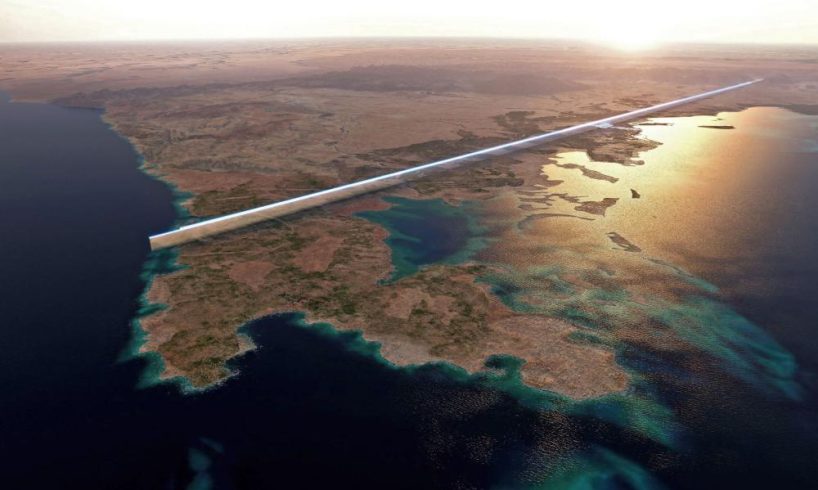
Photograph: NEOM/AFP/Getty Images
When Fifa’s team of inspectors travelled to the north-west of Saudi Arabia a fortnight or so ago, they needed to bring vibrant imaginations. They were scoping out one of the probable venues for the 2034 World Cup but this was no usual reconnaissance mission. It is one thing when, more than a decade out, a stadium is unbuilt but quite another when the same goes for an entire host city. Visualising a semi-final between, say, England and Brazil is not straightforward when you are gazing into a trench.
That was the case when a delegation from football’s governing body visited Neom, a mind-boggling project whose centrepiece will be a high-rise line in the desert that measures 105 miles long and 200 metres wide, ultimately accommodating nine million people. The plans that have been released look akin to a video game. Details of its progress are closely guarded but excavation works are well under way and there is a pledge to begin moving people in by 2030. The city will contain several stadiums and if Saudi Arabia gets its way, which happens more often than not, Neom will become one of the most important sporting venues on Earth.
Related: Saudi Arabia lacks community and political dignity to be a global football hub | Philipp Lahm
Barring unforeseen advances in construction technology, Fifa will be taking a leap of faith when it signs off Saudi Arabia’s bid towards the end of 2024. If Neom is passed as a venue it will be betting on an unprecedented infrastructural project that cannot be assessed in working order and may never be realised in entirety. But leaving the country’s flagship project out of the biggest sporting event on the planet would appear to defeat the object.
It may not be the only chance Fifa takes. The Saudis were announced as sole bidders for the 2034 competition in October and subsequently proclaimed as hosts via an Instagram post by Gianni Infantino. The sense is that they could present a bid book of children’s cartoons by the July deadline and still be waved through. But there was little willingness in Jeddah, where Saudi Arabia hosted a successful enough Club World Cup this month, to delve into the nuts and bolts of what the tournament might look like. Figures close to the bid want it seen that they are observing due process before rolling out the details.
Two of the problems that dogged Qatar 2022 should be headed off early. It was not until 2015 that Fifa admitted the last World Cup, originally scheduled for summer, would have to be held in the cooler winter. This time it is expected that, at the outset, Saudi Arabia will commit to a winter tournament: it will present fresh calendar issues and cause consternation among clubs, who were promised Qatar was a one-off, but the dropping of any pretence may be welcomed.
The tournament also looks certain to be alcohol-free, although a change in local laws cannot completely be ruled out given the pace of Saudi Arabia’s modernisation. Beer and fancier beverages will be off the menu as things stand, which may prove more of an issue selling hospitality packages than in the stands. Again, early clarity would work in the organisers’ favour: the shambles that surrounded Qatar’s late U-turn regarding alcohol provision at venues was entirely avoidable and created a mountain from what should have been a molehill.
Issues of greater seriousness must be scrutinised properly before anyone can roll out the red carpet for Saudi Arabia. It remains to be seen exactly how the country’s human rights record conforms to Fifa’s guidelines, which are nominally aligned with the UN’s Guiding Principles on Business and Human Rights. Question marks hover over at least one potential World Cup venue and Fifa will be expected to ensure any guarantees to protect workers’ rights, in particular, go beyond window dressing. Although it is suggested that Saudi Arabia, with a population of almost 36 million, will have less dependence on a low-paid foreign workforce to build its stadiums than Qatar, the reality is there are about 10 million migrant workers in the country. Reports of serious abuse and maltreatment have been numerous.
There are also concerns that locals have paid an awful price for the government’s megaprojects to date. The proposed new World Cup stadium, earmarked for the site of a desalination plant next to the Red Sea, is an extension of the sprawling Jeddah Central project that has resulted in mass evictions and displacements on spurious pretexts. A sobering and essential report from ALQST, a human rights organisation that focuses on events in Saudi Arabia, details the violations inflicted upon members of the Huwaitat tribe early in the construction process for Neom. Fifa’s tournament will need balletic deftness to avoid touching any such issues.
Human rights bodies, their resources understandably stretched by events elsewhere in the Middle East, will intensify their attention on Saudi Arabia as the bid deadline nears. They will hold it to account, as much as is possible in a state where they are routinely denied access, and expect Fifa to do so with similar honesty.
Nobody watching the Jeddah-based side Al-Ittihad, roared to the rafters by a vast home support, at the Club World Cup would doubt the Saudi enthusiasm for football. Nor would those who joined Infantino among the crowd of 4,500 watching the local women’s derby earlier this month. But the uncertainties around the 2034 bid go beyond the pitch, both in its ambitious scope and the potential human cost. As Fifa’s representatives surveyed the vast building site in Neom, a decade may have felt nowhere near long enough.






